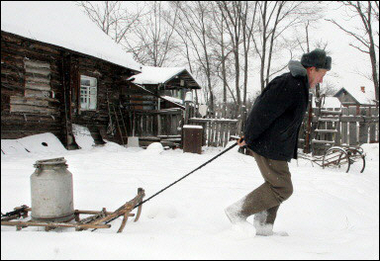|
China to help Russia tackle toxic slick
(AP)
Updated: 2005-11-30 22:36
China will send experts and equipment to Russia to help curb environmental
damage as a toxic slick slowly but inexorably approaches their common border.

An elderly man pulls a jug of water toward his
house in Khabarovsk. China will send experts and equipment to Russia to
help curb environmental damage as a toxic slick slowly but inexorably
approaches their common border. [AFP] |
The assistance comes after a visit to northeast China's Heilongjiang province
by officials from Khabarovsk, the region of Russia that is likely to see the
heaviest impact when the slick enters along the Songhua river.
"The Russian delegation will take the equipment home," said a spokesman of
the Heilongjiang environmental bureau, who identified himself by his surname
Zhang.
The equipment, used for monitoring water quality, will be sent to Russia
ahead of the arrival of the slick, expected in Khabarovsk in about 13 days'
time.
"In the beginning we wanted to give them a full new set of equipment, but
they saw the equipment we already used was working well, so they wanted this set
of equipment," he said.
Harbin, the capital of Heilongjiang, suffered a five-day water shutdown after
a blast at a PetroChina plant upstream released 100 tonnes of chemicals into the
Songhua, which provides most of the city's drinking water.
Fifty tonnes of the chemicals were estimated to have been absorbed in the
river bed and deposited along the banks above the city, Xinhua said, citing
environment officials.
The other 50 tonnes were believed to have passed through Harbin and were
still posing a danger for many others in cities downstream, and also on the
Russian side of the border.
"We will send experts to Russia to give training lessons but the equipment
will go first, and the experts need to go through some procedures," said Zhang.
"They are all experienced experts in our environmental protection bureau."
China apologized to Russia over the weekend for the problems the slick, made
up mainly of the carcinogen benzene and nitrobenzene, was
causing.
|